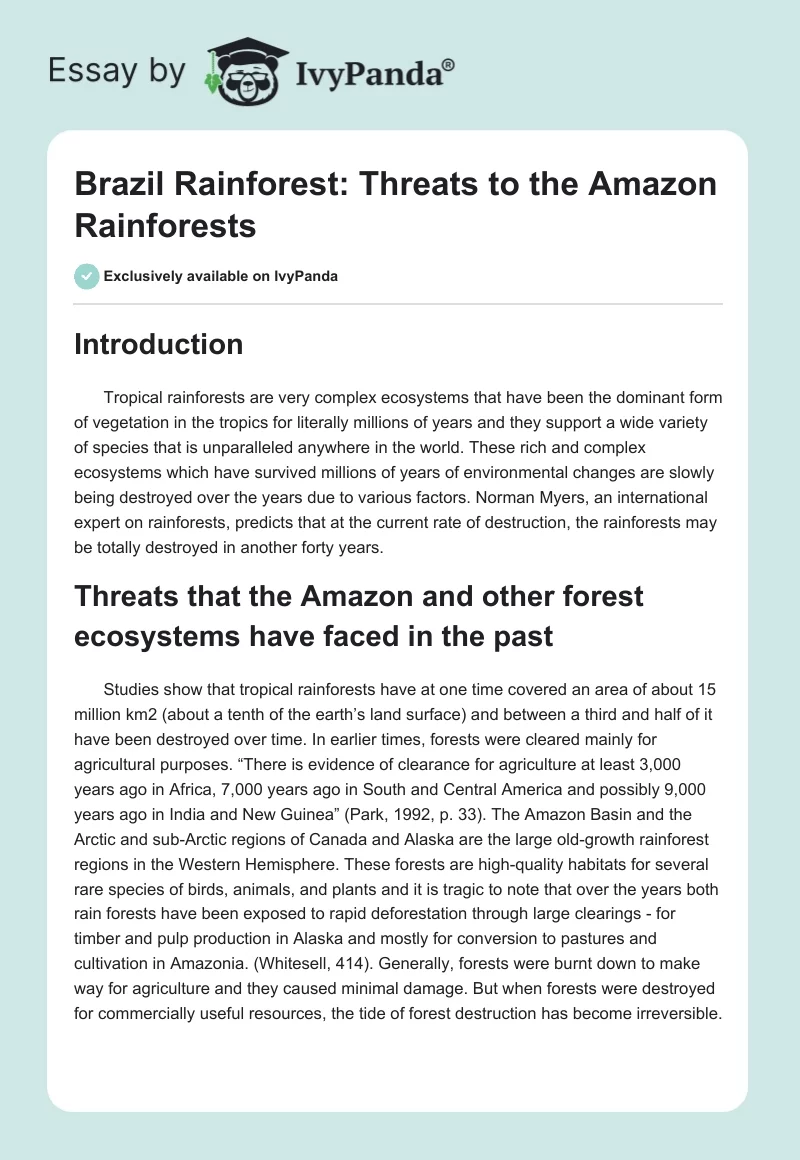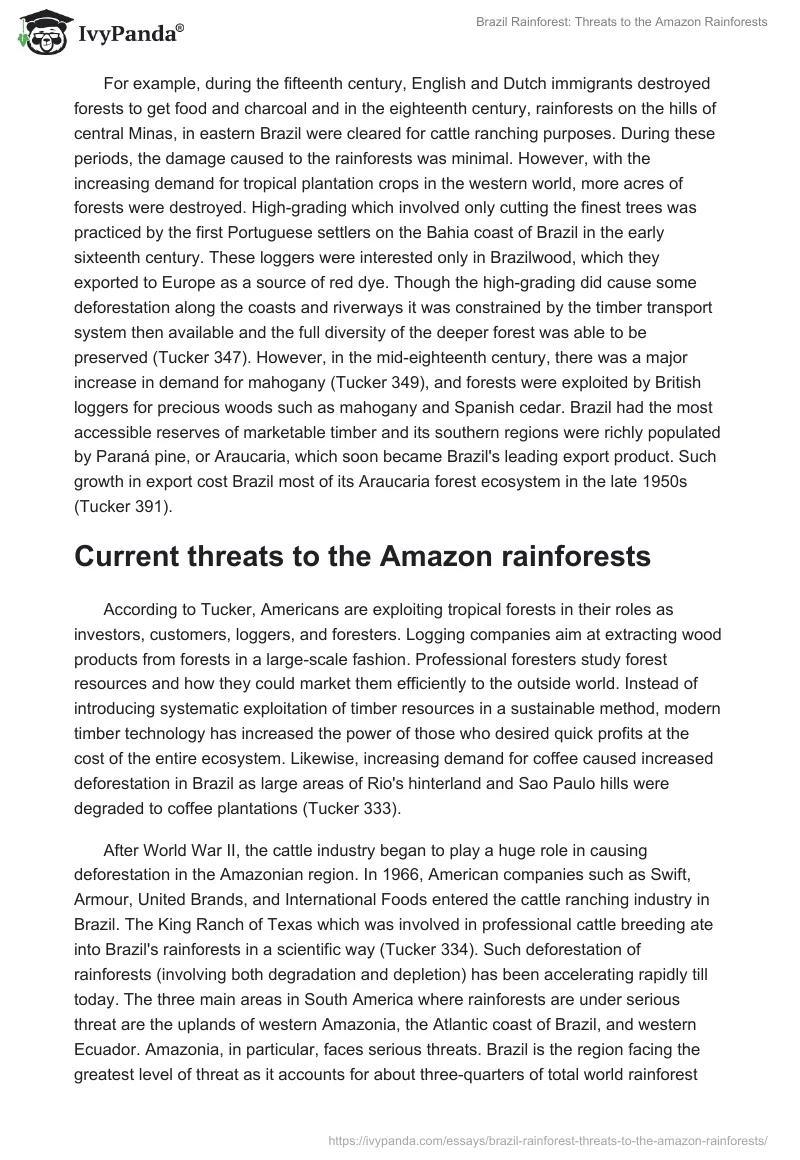Introduction
Tropical rainforests are very complex ecosystems that have been the dominant form of vegetation in the tropics for literally millions of years and they support a wide variety of species that is unparalleled anywhere in the world. These rich and complex ecosystems which have survived millions of years of environmental changes are slowly being destroyed over the years due to various factors. Norman Myers, an international expert on rainforests, predicts that at the current rate of destruction, the rainforests may be totally destroyed in another forty years.
Threats that the Amazon and other forest ecosystems have faced in the past
Studies show that tropical rainforests have at one time covered an area of about 15 million km2 (about a tenth of the earth’s land surface) and between a third and half of it have been destroyed over time. In earlier times, forests were cleared mainly for agricultural purposes. “There is evidence of clearance for agriculture at least 3,000 years ago in Africa, 7,000 years ago in South and Central America and possibly 9,000 years ago in India and New Guinea” (Park, 1992, p. 33). The Amazon Basin and the Arctic and sub-Arctic regions of Canada and Alaska are the large old-growth rainforest regions in the Western Hemisphere. These forests are high-quality habitats for several rare species of birds, animals, and plants and it is tragic to note that over the years both rain forests have been exposed to rapid deforestation through large clearings – for timber and pulp production in Alaska and mostly for conversion to pastures and cultivation in Amazonia. (Whitesell, 414). Generally, forests were burnt down to make way for agriculture and they caused minimal damage. But when forests were destroyed for commercially useful resources, the tide of forest destruction has become irreversible.
For example, during the fifteenth century, English and Dutch immigrants destroyed forests to get food and charcoal and in the eighteenth century, rainforests on the hills of central Minas, in eastern Brazil were cleared for cattle ranching purposes. During these periods, the damage caused to the rainforests was minimal. However, with the increasing demand for tropical plantation crops in the western world, more acres of forests were destroyed. High-grading which involved only cutting the finest trees was practiced by the first Portuguese settlers on the Bahia coast of Brazil in the early sixteenth century. These loggers were interested only in Brazilwood, which they exported to Europe as a source of red dye. Though the high-grading did cause some deforestation along the coasts and riverways it was constrained by the timber transport system then available and the full diversity of the deeper forest was able to be preserved (Tucker 347). However, in the mid-eighteenth century, there was a major increase in demand for mahogany (Tucker 349), and forests were exploited by British loggers for precious woods such as mahogany and Spanish cedar. Brazil had the most accessible reserves of marketable timber and its southern regions were richly populated by Paraná pine, or Araucaria, which soon became Brazil’s leading export product. Such growth in export cost Brazil most of its Araucaria forest ecosystem in the late 1950s (Tucker 391).
Current threats to the Amazon rainforests
According to Tucker, Americans are exploiting tropical forests in their roles as investors, customers, loggers, and foresters. Logging companies aim at extracting wood products from forests in a large-scale fashion. Professional foresters study forest resources and how they could market them efficiently to the outside world. Instead of introducing systematic exploitation of timber resources in a sustainable method, modern timber technology has increased the power of those who desired quick profits at the cost of the entire ecosystem. Likewise, increasing demand for coffee caused increased deforestation in Brazil as large areas of Rio’s hinterland and Sao Paulo hills were degraded to coffee plantations (Tucker 333).
After World War II, the cattle industry began to play a huge role in causing deforestation in the Amazonian region. In 1966, American companies such as Swift, Armour, United Brands, and International Foods entered the cattle ranching industry in Brazil. The King Ranch of Texas which was involved in professional cattle breeding ate into Brazil’s rainforests in a scientific way (Tucker 334). Such deforestation of rainforests (involving both degradation and depletion) has been accelerating rapidly till today. The three main areas in South America where rainforests are under serious threat are the uplands of western Amazonia, the Atlantic coast of Brazil, and western Ecuador. Amazonia, in particular, faces serious threats. Brazil is the region facing the greatest level of threat as it accounts for about three-quarters of total world rainforest clearance. “The Amazon rainforest in Brazil covers an area of 3.37 million km2, and an estimated 148,000 km2 had been cleared by 1983. Roughly 10,000 km2 more is cleared each year” (Park, 1992, 39). Currently, the Amazon rainforests face threats due to a number of factors such as climate change, forest fires, deforestation, and cattle ranching.
Climate Change: Climate change will affect all types of ecosystems in the world. According to a recent study by the Hadley Center of the U.K. Meteorological Office, it has been projected that climate change over the twenty-first century can cause the disappearance of most of the Amazon rainforest due to hotter and dryer conditions and replaced by tropical savanna – a tree grass mix similar to what is there along the southern and southeastern edges of the Amazon Basin (Wilson 107). Destruction of rainforests can result in the loss of timber, food, and medicines. Moreover, in the absence of rainforests, the region’s capacity to store carbon will be diminished and as a result, a large amount of carbon will be released into the atmosphere causing further warming and promoting further carbon release (Wilson 107).
Forest Fires: In the rainforests of the western Amazon, there is a period known as the burning season which is a period of two months or so between the two natural climatic seasons of the region – the dry and the wet. This was the time when wealthy ranchers and small farmers set their land on fire to clear the clogged fields or freshly deforested land and to replenish the soil with fresh nutrients. However, sometimes fires may be used to reinforce a claim to land in the Amazon (Revkin 8). When thousands of fires burn simultaneously, during the burning season, there is the greenhouse effect – global warming caused by the trapping of solar energy in the atmosphere which in turn is caused by the release of billions of tons of gases released each year by the burning of fossil fuels and forests (Revkin 14). Global warming can cause climate change and thus impact the Amazon forests in a destructive way.
Deforestation, Cattle ranching, and Logging: In the first years of the millennium Brazil’s deforestation level has steadily climbed to a peak at 10,500 square miles in 2004, the second-highest year on record (Schwartzman and Moutinho 16). This is mainly due to increasing global demand for soy in China and Europe, a rise in global prices of beef, and a weak real (Brazilian currency). Amazon forests have been cleared to produce 2 million tons of soya year. Moreover, Brazil’s cattle market is about to expand as well due to increasing demand for beef from Russia and the Middle East (Schwartzman and Moutinho 16). Moreover, it is predicted that selective logging, for rapidly dwindling supplies of mahogany and other precious hardwoods, may induce deforestation every year.
Some viable solutions to the problem of deforestation in the Amazon
According to basic economic theory, forest clearing should be taxed on the premise of the missing market for forest services. But Brazil has been doing the opposite by subsidizing forest conversion through “federal road building, subsidized rural credit, and various tax exemptions for economic activities involving forest clearing” (Andersen et al., 2002, 204). To prevent deforestation, the total economic value (TEV) of the standing forest must be greater than the value of the converted forest and this benefit should accrue to Brazil if it were to halt deforestation. To ensure that Brazil benefits through deforestation, there must be incentives provided. The best way would be to have an international parks agreement according to which the international community aggress to pay the rental price of land, plus possibly the management costs as well, for each year that the park remains protected (Andersen et al, 204).
However, if the international community desires that some forest areas must be totally untouched, they should be willing to pay the extra price for it that includes the opportunity costs. By allowing some economic activities, such as sustainable timber harvesting, the international community may bargain to pay a lesser price to Brazil in exchange for halting deforestation. Andersen et al. (2002) have suggested that “Brazil can offer to protect 200 million specific hectares of forest at the low cost of $2/hectare/year. However, for another 100 million hectares, it would be at $5/hectare/year because the opportunity costs and the costs of protection are higher in these less remote areas” (Andersen et al, 2002, 205). Anderson et al have also suggested that Brazil could offer different levels of protection for different payment rates. In this method, the international community and Brazil enter into an agreement regarding how much forest Brazil can protect and how much the international community will pay. By repeating this procedure on an annual basis, the greatest amount of forest can be protected at the lowest cost.
However, this calls for the presence of an international agency that is authorized and well funded to make these negotiations. When there are more chances for the international community to offer payment for forest services, “the perceived value of intact forest in Brazil should also increase and this would encourage more international investment in environmental protection” (Andersen et al, 2002, 207). Another method of reducing deforestation is by limiting road-building efforts to already settled areas in the forest and avoiding virgin areas (Andersen et al 206). Moreover, if the living conditions of people in the settled areas are improved by public investment in the contexts of education and healthcare, it can indirectly help to relieve pressure on intact forest areas (Andersen et al. 206). Andersen et al (2002) have also suggested investing in agricultural methods to find optimum ways of land use. Though this will not directly reduce deforestation, it can make deforestation more justifiable. Moving in the right direction, Brazil is currently setting up very extensive and expensive environmental monitoring and data gathering programs. Such programs can help to reduce the exploitation of Amazonian forests and also empower Brazil to bargain with the rest of the world by proving its control over developments in the Amazonian region.
Works Cited
Andersen, E. Lykke; Clive W. J. Granger; Eustáquio J. Reis; Diana Weinhold and Sven Wunder. The Dynamics of Deforestation and Economic Growth in the Brazilian Amazon. Cambridge University Press, Cambridge: England, 2002.
Wilson, O. (FRW) Edward. Sustaining life: how human health depends on biodiversity. Secretariat of the Convention on Biological Diversity, United Nations Environment Program, Oxford University Press, US, 2008.
Park, C. Chris. Tropical Rainforests. Routledge Publishers, New York, 1992.
Revkin, Andrew. The Burning Season: The Murder of Chico Mendes and the Fight for the Amazon Rain Forest. Island Press, 2004.
Schwartzman, Stephan and Moutinho, Paulo. “Deforestation and Global Markets: An Amazonian Dilemma Brazil Has Become a Global Producer, and China a Global Consumer”. The American Prospect, 18:9 (2007).
Tucker, P. Richard. Insatiable Appetite: The United States and the Ecological Degradation of the Tropical World. University of California Press, Berkeley: CA, 2000.
Whitesell, A. Edward. “Local Struggles over Rain-Forest Conservation in Alaska and Amazonia”. The Geographical Review, 86:3 (1996).


